Learn the benefits of rainwater and harvesting it with rain barrels and other containers, along with how to get started.
Did you know that one inch of rain on a 1,000-square-foot surface like a roof can create over 600 gallons of water? Living in San Diego, we may be more accustomed to understanding drought restrictions and being waterwise in the garden. With rainfall limited and water prices increasing, you may want to consider harvesting rainwater with rain barrels or cisterns.
The Benefits of Rainwater
My favorite time to walk through the garden is after a rainstorm. The leaves are standing taller, the drops are glistening in the morning sun, and you know the earthworms and roots are doing the tango in the moisture, nutrient-saturated soil. Houseplant enthusiasts will scramble to move their plants outside during a light rain to soak up the benefits. Plants love rainwater!
The benefits of using rainwater in your garden are:
- Rain is slightly acidic, which is beneficial for plants and the soil.
- There’s no chlorine or additional hard water chemicals like salts and minerals that are added to municipal water, making pure and soft water for your plants to soak up.
- Salts and minerals tend to build up in our soil, particularly pots, and rainwater helps to flush out our soils.
- Whether from the sky or a barrel, this water is often warmer and less of a shock to plants than colder water from a hose.
- Rainwater contains light organic material, like crushed leaves or bird droppings that accumulate on our roofs and gutters, and infuse it with natural fertilizers.
The Benefits of Rain Harvesting
Collecting rain varies from simple to complex, from a good old-fashioned bucket to rain barrels connected with a gutter system to a complex rain harvesting system often installed by professionals. Most homes can harvest rainwater simply through the use of rain barrels/buckets/trash cans placed strategically on your property under downspouts or angles like where eaves meet on your roof.
If a home has gutters, most rain barrels are designed to connect directly to a downspout in a gutter system. If you are using a DIY system to collect rainwater, make sure the collected water is covered to prevent mosquitoes.
The benefits of using rain barrels are:
- Protecting the environment: When rainwater is collected, it doesn’t make contact with trash and street pollutants, and prevents untreated and contaminated water from entering our local water systems. It also reduces flooding, drainage problems, and standing water, which is a breeding ground for mosquitoes.
- Saving money: For every gallon you collect, that is one less gallon you pay for.
- Using later: You can save and use water during summer and fall when drought restrictions are typically enacted.
- Watering indoors: Rainwater is a great source of nutrient-rich water for houseplants.
- Conserving energy: A majority of our water is pumped in from the Colorado River and the San Joaquin Valley using electricity. We can reduce our energy consumption by transporting less water into our region.
How to Get Started Saving Rain
When it comes to rain harvesting in San Diego, we have a wealth of knowledge and options right in our backyard! The Solana Center is a comprehensive resource for everything green in San Diego County. They provide education and support on composting, recycling, food waste management, and rain harvesting. Sign up for a free Rain Harvesting class and investigate 50-gallon rain barrels (the size most homes utilize) to purchase. Rain barrel styles, designs, and installers vary, and San Diego County has a list with a variety of local options. Here’s a link to Lowe’s to see their options.
If you are looking to build a rain harvesting system in your garden, you can also look into small local businesses, like the home garden center Plants Por Favor, tucked into the heart of South Park. They provide consulting and installation options for a more complex system that could include harvesting, greywater, native landscape design, and stormwater management.
Most San Diego region residents qualify for a $35 rebate for up to tow rain barrels (50 to 199 gallons) or larger Cisterns (200 to 1000-plus gallons) through the SoCal Water Smart Rebate. (Currently, the San Diego City rain barrel rebate program is on hold due to the recent flooding and a reallocation of these funds.)
Remember there is no right way or one-size-fits-all to gardening, being waterwise, or collecting rainwater. Figure out what works for your home, skill level, finances, and do it! It’s our combined efforts as a global community that will make a difference!
Wildflower Rainwater Tip:
Harvest the power of rainwater when planting seeds. This winter before a rainstorm, head out to the garden with a packet of native wildflower seeds. Empty the packet in your hands and scatter the seeds over the soil. That’s it! No need to individually sow each seed. Come spring, you will see tiny wildflowers starting to emerge just like nature intended.


